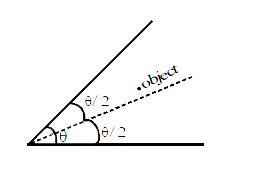Which type of lens forms always a virtual image ?
To determine which type of lens always forms a virtual image, we can follow these steps:
Step 1: Understand the Types of Lenses
There are two main types of lenses: convex lenses and concave lenses.
Step 2: Analyze Convex Lenses
Convex lenses are thicker in the middle and can converge light rays. They can form both real and virtual images depending on the position of the object relative to the lens. When the object is placed within the focal length of a convex lens, it forms a virtual image. However, it does not always form a virtual image.
Step 3: Analyze Concave Lenses
Concave lenses are thinner in the middle and diverge light rays. They always cause parallel rays of light to spread out as if they are coming from a focal point behind the lens.
Step 4: Determine Image Formation
When an object is placed in front of a concave lens, the light rays diverge, and if we extend the diverging rays backward, they appear to converge at a point behind the lens. This point is where the virtual image is formed.
Step 5: Conclusion
Since a concave lens always forms a virtual image regardless of the position of the object, we can conclude that the type of lens that always forms a virtual image is the concave lens.
Final Answer
The type of lens that always forms a virtual image is the concave lens.
---
There are two main types of lenses: convex lenses and concave lenses.
Convex lenses are thicker in the middle and can converge light rays. They can form both real and virtual images depending on the position of the object relative to the lens. When the object is placed within the focal length of a convex lens, it forms a virtual image. However, it does not always form a virtual image.
Concave lenses are thinner in the middle and diverge light rays. They always cause parallel rays of light to spread out as if they are coming from a focal point behind the lens.
When an object is placed in front of a concave lens, the light rays diverge, and if we extend the diverging rays backward, they appear to converge at a point behind the lens. This point is where the virtual image is formed.
Since a concave lens always forms a virtual image regardless of the position of the object, we can conclude that the type of lens that always forms a virtual image is the concave lens.
The type of lens that always forms a virtual image is the concave lens.
Topper's Solved these Questions
Similar Questions
Knowledge Check
- Question 1 - Select One or More
Which of the following always forms virtual image for real objects ?
AConcave lensBconcave mirrorCConvex mirrorDconvex lens - Question 2 - Select One
Which of the following can form a virtual image which is always smaller than the object?
AA and BBB and CCA and CDB and D
Which of the following can form a virtual image which is always smaller than the object?
View SolutionA concave lens always forms a virtual image.
True/FalseView SolutionAssertion : For given system (θ=72∘), number of images formed is 5
Reason : A plane mirror always form a virtual image of a real object
 View Solution
View SolutionName the type of mirror which always forms a virtual and diminished image.
View SolutionA concave lens always forms a virtual image.
True/FalseView SolutionA concave lens always forms a virtual image. (T/F)
View Solution

